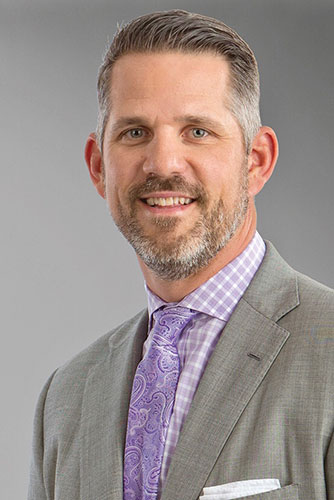A Joint Replacement Surgeon’s Perspective on Multimodal Pain Management

When Jeffrey Hodrick, M.D., an orthopedic surgeon at the Southern Joint Replacement Institute (SJRI) in Nashville, Tennessee, consults with a patient about knee or hip surgery and its aftermath, he discusses how multi pronged approaches to pain management can be part of an Enhanced Recovery After Surgery (ERAS) process.
Some of his patients are adamant about what they don’t want after they receive a joint replacement—opioids. Wary of becoming addicted and fearful of nausea and other side effects, these patients are eager to hear Hodrick, who also serves as a HealthTrust Physician Advisor, explain new ways to help them attack and control pain without relying on these narcotic painkillers. Though some patients are ready to avoid narcotics, others need more convincing to try new approaches, particularly older adults recovering from a significant joint replacement who might have more difficulty with the clinical mandate to get up and get moving as quickly as possible.
Regardless of the patient population, education is the key to unlocking a successful ERAS and multimodal pain management strategy. Hodrick offers the following guidelines for health systems wanting to provide alternate options for pain control.
- Educate and help set expectations. SJRI starts the process by offering patients preoperative classes to explain the magnitude of their upcoming hip or knee surgery. Hodrick tries to manage his patients’ expectations about the pain and inflammation involved and the length of the recovery.
“It is important to be honest,” he says. “You provide better quality care when you help patients know what to anticipate.” - Use non-narcotic medicines in the perioperative period. Hodrick’s team applies anesthetic techniques, with an emphasis on neuraxial and regional blockades, to provide initial pain relief to patients while reducing their potential complications and side effects. During a knee replacement, for instance, the anesthesia team numbs the patient’s leg while she is under a spinal anesthetic, allowing the patient to breathe on her own rather than through a tracheal tube. The nerve block provided by the regional anesthesia helps alleviate pain for the first 18 to 24 hours after the procedure.
Hodrick’s team also administers periarticular block medicine, an anti-inflammatory drug that reduces swelling in the soft tissue around the joint. This allows patients to start moving soon after surgery, preferably within five hours. Taking those initial steps so quickly allows them to clear a big physical and psychological hurdle.
“If you can get the patient up and walking and bending their joint without significant discomfort, you are sending an important message. You are telling the patient, ‘OK, we can do this,’” Hodrick says. Steroids are also given to reduce the inflammation and control nausea.
After surgery, some patients use a battery-operated TENS (Transcutaneous Electrical Nerve Stimulation) machine to modulate the pain response, or nerve conduction, to the brain. Hodrick also recommends combination therapy using over-the-counter pain relievers to help alleviate pain or discomfort.
“I am a big believer in Tylenol,” he says. “It is a good, benign agent, and people can get the maximum benefit when they take it on a regular schedule,” he says. - Cut down on opioid prescriptions—within reason. Hodrick underlines the point that eliminating or significantly reducing the use of opioid medications for pain management can enhance recovery time, without the negative side effects often experienced with opioids. However, he realizes that, despite the many available pain-relief techniques, some patients may still suffer pain, especially after a knee replacement. National headlines warning of the risks of opioids have led to more awareness of abuse, but they also chased away some patients who could benefit from them.
“There is a huge pendulum swing,” he says. Though controlling opioids is necessary, “cutting opioids out completely is not appropriate for all patients having major surgery.” - Encourage proper disposal of opioids to decrease diversion. When he does prescribe narcotic painkillers, Hodrick does so at a minimal level and weans the patient off them as soon as possible. He says most of the joint replacement patients he has seen do not struggle with opioid addiction. However, he sees risk in those situations where patients don’t safeguard their narcotics, enabling others in their home to easily access the drugs for sell or use. He underscores the importance of properly disposing of unused medications, urging patients to check with their pharmacists or public health sources about “take back days” for opioid prescriptions.
- Stay current on the latest pain management treatments. Passionate about continuing education, Hodrick is constantly studying experimental treatments to alleviate pain. Cryoablation, which uses extreme cold to kill tissue, holds promise. “By ablating the sensory nerves around the knee, we can hopefully reduce the need for strong pain medicines following surgery,” he says.
- Work as a team. SJRI employs a multidisciplinary approach to both pain management and opioid stewardship. Surgeons, anesthesiologists, nurses, pharmacists and others work together to manage how much and when opioids are dispensed. The group is also committed to getting patients in the best possible health before surgery to help with recovery, offering nutrition and tobacco cessation classes to help reduce complications. After surgery, patients are prescribed physical therapy to increase mobility and decrease pain.
While he follows certain protocols, Hodrick treats a patient’s pain on a case-by-case basis. “Pain is so complicated, and tolerance of it is such an individual matter.
Pain is not simply a physical sensation, an electrical signal going to and from the brain—people also experience emotional and psychological aspects,” he says.
“Some people do better with pain than others, likely due to genetics and their chemical makeup. You can’t quantify pain as easily as you can other symptoms.”
Above all, he listens to his patients and stays open to new pain treatment methods.
“More patients are now saying, ‘I want to go through surgery with minimal narcotics,’” he says. “And, when you tell them you have a plan, they are very open to it.”
Share Email Opioids, Pain Management, Patient Experience, Q2 2018, Surgery






